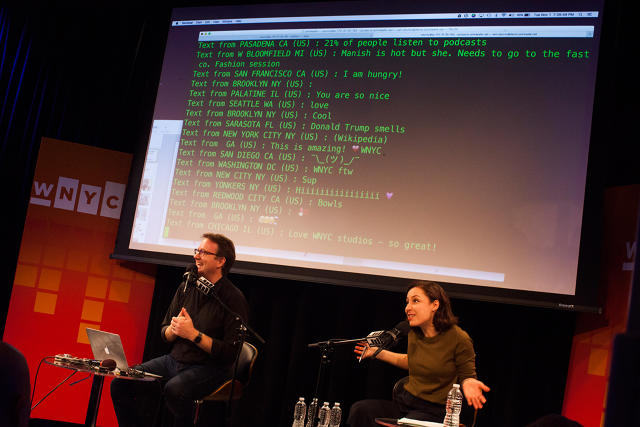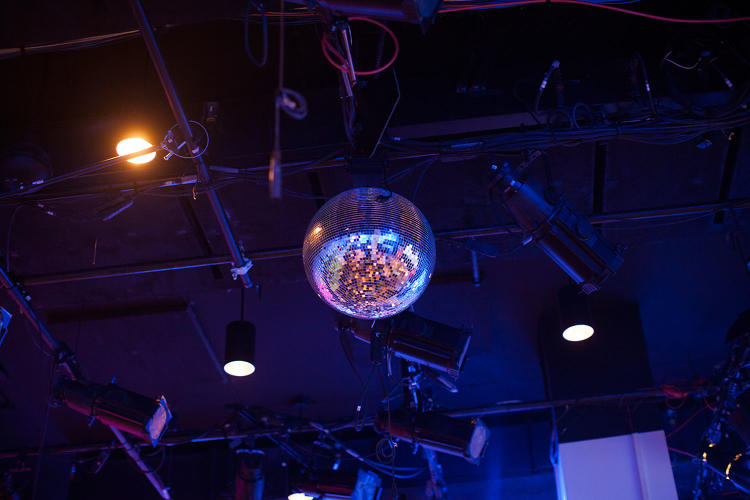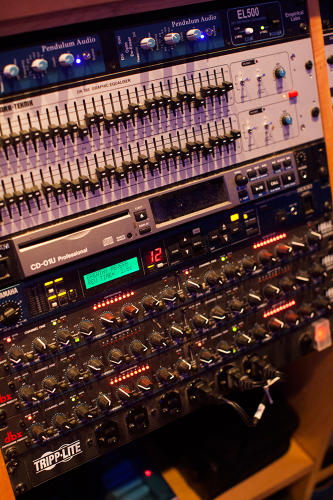For WNYC, Radio’s Future Is All About Experimentation
Anyone who thinks old-school media can’t be stealthy and innovative has never seen John Keefe text a room full of people from a command line on his laptop. But tonight, the senior editor for data news at WNYC—a public radio station founded in 1924—is showing off some things he built to help his colleagues tell stories.
“We find that text messaging is really, really useful for a lot of things,” Keefe said during a presentation at Fast Company’s 2016 Innovation Festival earlier this month. In this case, he demonstrated how a simple chatbot running on his own server can be used to interact with a large group of people at once. It can ask simple questions, pull together insights, and respond in real time. Keefe asked everyone in the room to send a text message to the phone number he displayed onstage, and within seconds, his laptop screen was buzzing with line after line of incoming messages. One by one, the audience members turned their attention back to their smartphone screens as the bot started to respond and a few dozen virtual conversations began.

Keefe’s demo was meant to introduce the concept of an SMS-based chatbot, but it’s more than just a prototype. Earlier this year, Keefe and his team used this technology to help the WNYC podcast Note to Self conduct an experiment with its listeners. In an attempt to understand and combat information overload, the show embarked on a project called Infomagical that challenged listeners to focus only on one task at a time by using a text chatbot to remind listeners of their stated goal, encourage them, and solicit feedback via voicemail.
“Computers are infinite in their power, but your brain is not,” said Manoush Zomorodi, the host of Note to Self, noting the deluge of emails, social posts, and news many of us mainline into our brains each day. “We have a limited amount of glucose every single day. Once you’ve burned through it, you don’t get more.”
Studies show that knowledge workers waste a quarter of their time on streams of data, costing the economy $990 billion each year, Zomorodi said. The Infomagical project yielded responses from over 54,000 people, not only providing insight for the podcast, but piquing the interest of outside researchers.
For WNYC, it was just one example of how the decades-old institution uses new technology to augment its reporting and interact with its audience in ways that would have sounded like pure science fiction when WNYC first started to beam news across New York City from its broadcast towers in 1924. Through its recently minted WNYC Studios arm, the station continues its longtime presence in the podcasting space (popular shows like Radiolab, Freakanomics, and On the Media are all WNYC originals), but also tries to find new boundaries to push, leaning on geeks like Keefe and Zomorodi to help feel out what’s possible.
“If you don’t own a radio and you’re not necessarily streaming the signal, I’m still assuming that you want what we have and you just need another way to get it,” said Dean Cappello, WNYC’s executive vice president and chief content officer. “As the audience behavior has become really fractured, what people really connect to is that voice. The brand at the show level.”
To Cappello, it doesn’t matter if you stumble across On the Media on the FM radio dial—which remains a vastly more popular medium than podcasting—or if you find it in an app like Stitcher alongside Zomorodi’s Note to Self and the rapidly expanding catalog of other podcasts out there. WNYC’s strategy, Cappello says, is to be everywhere.
“You have to fight every moment of the day for somebody’s attention,” Cappello said. “And if you’re not doing that, they’re going to move on to something else.”
In a sense, the real competition for podcasts and radio shows is everything else people can consume attentively, from Netflix and the New York Times to five-second clips on Snapchat and an endless scroll of Facebook updates. But Cappello doesn’t overlook the growing army of outlets producing radio-style audio content that competes directly with what WNYC has done for decades. The increased competition, he claims, is welcome.
“If you look at the top ranks of iTunes, it’s full of either public radio content or content from people who used to work at places like this,” Cappello said. “There’s this beautiful creative diaspora that’s going on that I think is really amazing.”
For now, public radio still dominates the podcasting landscape, but that could change soon. Podcasting is in the midst of a boom as venture capital flows into the business and podcasters expect a 25% growth in ad revenue every year until 2020.
And it’s not just the content that’s expanding. Public radio vets like former NPR reporter Steve Henn and PRX cofounder Jake Shapiro are working on digital audio distribution apps of their own, with Henn’s platform 60db teaming up with publishers to produce thousands of new audio stories per day. Gimlet Media, a two-year-old startup valued last year at $10 million, is just one of the new players churning new podcast titles that offer the depth and quality of public radio offerings without all the institutional baggage of a legacy media operation.
To Cappello, this rapid proliferation of new audio content isn’t a threat so much as a challenge for his team to keep innovating. “The competition is only scary if we’re not willing to be competitive,” he said. “I will put all of the staff here up against any staff that’s out there.”
This is where people like Keefe and a penchant for experimentation can really come in handy. By marrying traditional reporting and production with new technology, WNYC Studios hopes to keep expanding on what it can offer while the competition grows.
The Harlem Heat Project is another reporting venture that offers an illustration of how technology and outside-the-box thinking can create new possibilities for public radio. When WNYC reporter Sarah Gonzalez wanted to learn more about how the summer heat affects New York’s low-income residents, she turned to Keefe for his hardware know-how.
In collaboration with AdaptNY, WNYC’s team built 50 small, internet-connected temperature sensors and asked residents of low-income housing in Harlem to let them leave the sensors in their apartments. The sensors allowed them to measure something that is not typically accounted for—indoor temperatures—and revealed just how oppressively hot summer can be for those who can’t afford air conditioning. The resulting data visualization showed that, even as temperatures fluctuated in the mornings and evenings, non-air-conditioned apartments remained excessively warm, sometimes hovering at around 90 degrees Fahrenheit at night, despite much cooler temperatures outside.

Through experiments like these, WNYC hopes to keep competitors at bay with a two-pronged approach: Produce original content that others can’t easily mimic, and find new ways to engage ever more distracted listeners. In the age of Netflix, organizations like WNYC are under growing pressure to produce shows that are not just bingeworthy but also buzzworthy.
“It’s a kind of magnetic pull to a thing that everybody will talk about at the watercooler tomorrow and that everybody will go home and try to consume,” Cappello said. “We just don’t control how you consume it anymore.”
Manoush Zomorodi, host of Note to Self, talks how WNYC keeps innovating despite its age.



Backstage at WNYC Studios.

Manoush Zomorodi, host of WNYC’s Note to Self.

WNYC Chief Content Officer Dean Cappello.

WNYC staff discuss the public radio outlet’s efforts evolve and engage audiences as podcasting finally comes of age.


Fast Company , Read Full Story
(51)





